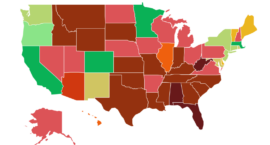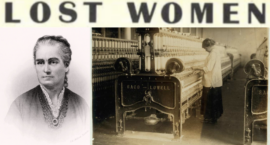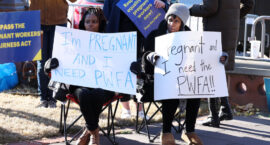The U.S. Equal Employment Opportunity Commission (EEOC) released its final regulations implementing the Pregnant Workers Fairness Act (PWFA). The landmark statute mandating “reasonable accommodation” of workers’ pregnancy-related needs went into effect last summer, but the regulations explain the PWFA’s protections in more detail, providing additional guidance to workers, employers, and the courts so that the full force of the law is given effect.
Tag: Work
Who’s Budgeting for Women’s Futures?
For too many—especially women of color—paychecks aren’t keeping up. Inflation is inching downward, but costs for groceries, childcare and rent feel out of reach.
But congressional fights over taxes and spending are really about fundamental questions: What do women, our families and communities need? What kind of future do we want to build? Recent budget proposals by the Biden administration and Republicans in Congress show how our two major political parties answer those questions. The answers were starkly different, revealing high stakes when it comes to women’s ability to participate in the economy, care for their families and control their own reproductive lives.
The Best and Worst States for Family Care Policies
In 2021, the Century Foundation published its first care policy report card, “Care Matters,” which graded each state on a number of supportive family policies and worker rights and protections, such as paid sick and paid family leave, pregnant worker fairness, and the domestic worker bill of rights. The 2021 report card revealed the tremendous gaps in state care policies and a fragmented and insufficient system of care workers and families in most states.
This year’s update, co-authored with Caring Across Generations, takes another look at how states are doing.
Lost Women: Harriet H. Robinson, An American Mill Girl
Reclaiming the forgotten histories of women was the driving force behind Ms.‘ monthly column “Lost Women.” This Women’s History Month, we’re reviving the iconic series—diving into the archives to make these histories more accessible to our new age of Ms. readers.
This week: Harriet Robinson captured and preserved the fleeting golden age for female factory laborers—a unique period when the daughters of New England led the way in the transformation of America … and of themselves.
Federal Judge Rules Against Pregnant Workers in Texas
Texas AG Ken Paxton sued the Biden administration last year over a government funding package that passed largely by proxy votes because of the COVID-19 pandemic. The funding package, passed in December 2022, included the Pregnant Workers Fairness Act, which protects accommodations for pregnant employees and allows workers to sue employers for failing to do so.
Paxton argued the Constitution requires a physical majority of members to pass legislation. Since a majority voted on the funding package by proxy, Paxton said it was unenforceable. Judge James Wesley Hendrix of the Northern District of Texas agreed with Paxton’s understanding of a quorum—ruling the Pregnant Workers Fairness Act unenforceable against the state government and its agencies.
Subminimum Wage Is a Legacy of Slavery: Time for One Fair Wage
While some states have eliminated the subminimum wage, or raised it above the paltry federal rate, the vast majority of states still allow employers to pay servers less than minimum wage. Restaurant servers in the U.S. are about 70 percent female and disproportionately women of color. Young people, disabled workers and incarcerated people in many states also receive subminimum wages.
The system of subminimum wages and tipping is a legacy of slavery. After the Civil War, white business owners replaced wages with tipping because they did not want to pay their Black employees. Today, the subminimum wage harms women of color, in particular, who face biases from customers, which shows up in lower tips.
The Future of Pay Equity, 15 Years After Lilly Ledbetter Fair Pay Act
Fifteen years ago, we stood at the White House while then-President Obama signed the Lilly Ledbetter Fair Pay Act. This law restored the rights of employees to have their day in court for ongoing wage discrimination taken away by the Supreme Court in the Ledbetter v. Goodyear case.
This bill was such an important victory for workers and gave employees who were experiencing ongoing pay discrimination their day in court. However, the law did not give women new tools to combat the wage gap itself. Still, with all working women earning on average 77 cents for every dollar paid to their male counterparts—and the pay gaps even wider for women of color—it reminds us our work is still far from finished. We will not rest until we can enact more policies that give workers stronger tools to challenge pay disparities and other forms of employment discrimination.
What’s Next for #MeToo Legislation?
Six years after #MeToo went viral, significant state legislation has gone into law, with 25 states plus D.C. passing over 80 anti-harassment bills. Bipartisan action from the federal government led to President Biden signing both the Speak Out Act, to address predatory nondisclosure agreements; and the Ending Forced Arbitration of Sexual Assault and Harassment Act, to restore the ability of workers to take their employers to court—both in 2022.
This legislative progress is welcome, but there is more work to be done. It is laudable that 25 five states have enacted additional protection for workers against abusive NDAs and offer added legal shields when it comes to sexual harassment beyond federal statutes. But that leaves 25 states that have not.
The Law Needs to Talk About Menopause
The Pregnant Worker Fairness Act (PWFA) went into effect this summer. Perimenopause and menopause are related to workers’ reproductive lives and capacity for pregnancy. The inclusion of these terms will provide valuable guidance to employers and the millions of affected workers.
Latina Women Are Leading Their Fight for Equal Pay
In 2022, all Latinas with reported earnings were paid just 52 cents to the dollar paid to white, non-Hispanic male workers. In spite of every attempt to hold Latinas back, we are fighting the current, winning against all odds and leading the way towards change.












